Papers in English by Liviu Lutas

Published in Metacritic Journal for Comparative Studies and Theory 1.1 (2015)
...
The aim of thi... more Published in Metacritic Journal for Comparative Studies and Theory 1.1 (2015)
...
The aim of this study is to challenge the view that narrative metalepsis is incompatible with the writing about the past and history. I study three works by francophone writers in which metalepsis and another similar narrative device, syllepsis, are used in interesting ways in stories dealing in different ways with the past. In C F Ramuz’s short story Scène dans la forêt, both devices are used in order to give the reader the impression of being in physical contact with past events and with the fictional events represented in the story. The past here is of an individual type. In Marie NDiaye’s first story of her novel Three Strong Women, the individual past can be read as an allegory of France’s postcolonial relation to the former African colonies. Metalepsis is used in order to suggest that the character accepts her past. In Patrick Chamoiseau’s novel Biblique des derniers gestes, metalepses are used in order to suggest a physical contact with the forgotten history of slavery.
This article, published in De Gruyter's "Narratologia" series, analyses four cases of metalepsis ... more This article, published in De Gruyter's "Narratologia" series, analyses four cases of metalepsis in detective fiction: Jasper Fforde’s "The Eyre Affair" (2001), Arturo Pérez-Reverte’s "The Flanders Panel" (1990), Hiber Conteris’s "Ten Percent of Life" (1986) and Stephen King’s “Umney’s Last Case” (1993). The conclusion is that narrative metalepsis, which had previously been seen as a device compatible with high-brow literature, has found its way into popular forms of fiction too.
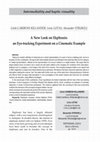
Taking the modern definition of ekphrasis as a verbal representation of a work of art as a starti... more Taking the modern definition of ekphrasis as a verbal representation of a work of art as a starting point, we try to broaden it in this contribution. We agree with intermediality theorist Lars Elleström that ekphrasis falls into the category of "media representation", defined as the representation of a source medium in a target medium. We argue that the target medium does not need to be a verbal one and what matters is the energeia, the vividness of the description, leading in turn to enargeia, a vivid image in the mind of the receiver. The energeia-enargeia relation is an aspect that is often neglected in modern theoretical debates about ekphrasis. We believe that there cannot be ekphrasis without a description making the receiver "see" the object with his/her inner eye. At the same time, following Seymour Chatman and Werner Wolf, we argue that description is not a prerogative of the verbal medium and that even the cinematic medium can describe, using different strategies.
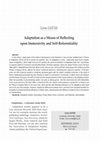
In this article, I apply parts of the method introduced by Linda Hutcheon in her recently reedite... more In this article, I apply parts of the method introduced by Linda Hutcheon in her recently reedited book A Theory of Adaptation (2010) and try to answer the question "why" an adaptation is made. I particularly study three complex cases of adaptation, which might even put into question the canonical definition of adaptation itself, but I concentrate on aspects related to immersion and self-referentiality. All these examples, which are Jasper Fforde's novel The Eyre Affair (2001), Abdellatif Kechiche's film Black Venus (Vénus noire, 2010) and Peter Greenaway's film Goltzius and the Pelican Company (2012), address the above mentioned aspects in interesting and ingenious manners. In Fforde's novel, the shift of genres permits a narratively advanced game with the reader's possible immersion in the world of fiction, challenging and broadening thus theories of reader's involvement or immersivity. In Black Venus and Goltzius and the Pelican Company, the shift of media and the residual presence of the source medium in the adapting medium offers the possibility of accomplishing subtler, but quite as daring games with the immersivity and self-referentiality of the source text as in The Eyre Affair. In Kechiche's film, the reaction of the audience is presented. In Goltzius and the Pelican Company there is one more level, which permits self-referential reflections on the adapted product itself and on the act of its reception. However, despite the differences between them, all these three examples illustrate the possibility to include theoretical reflections in artistic works, dissolving thus the difference between theory and practice (cf. Kamilla Elliot).
This paper, which is part of the Proceedings from the 4th International Conference of Education,... more This paper, which is part of the Proceedings from the 4th International Conference of Education, Research and Innovation, Madrid 2011, is an argument in favour of the use of literary theory in upper secondary school. Especially in Sweden, litterary theory has had a progressively diminishing role, since it has been seen as incompatible with the students' joy of reading. The results have been disastrous. Therefore, following advice as those advanced by Tzvetan Todorov, who is unaware of other contexts than the heavilly theorized, but in the wrong way, French school, is hardly the good way to go. Theory shoud rather be taught in new ways. The paper provides a couple of classroom examples where this has been done.
In this paper, which is a part of the Proceedings from the 4th International Conference of Educat... more In this paper, which is a part of the Proceedings from the 4th International Conference of Education, Research and Innovation, Madrid 2011, I describe an example of how ICT (Information and communication technologies) can be used in teaching literature at upper secondary level in Sweden in a way that lets the pupils become more active producers of knowledge in a flexible learning environment and promotes a globalized view of literature, especially of French literature, which goes beyond the nation’s borders.
Papers in French by Liviu Lutas
This article, written in French, is an attempt to examine the narratological device called syllep... more This article, written in French, is an attempt to examine the narratological device called syllepsis. Its relevance is tested in two case studies: two litterary works (C F Ramuz's short story "Scène dans la Forêt" and P Chamoiseau's novel "Biblique des derniers gestes") and two films (Ferzan Özpetek's "Loose Cannons" and Park Chan-Wook's "Old Boy".
Papers in Spanish by Liviu Lutas
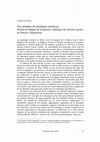
Dos ejemplos de metalepsis narrativas: Niebla de Miguel de Unamuno y Biblique des derniers gestes... more Dos ejemplos de metalepsis narrativas: Niebla de Miguel de Unamuno y Biblique des derniers gestes de Patrick Chamoiseau La metalepsis narrativa se define como el traspaso de la frontera entre el nivel diegético del narrador y la diégesis, es decir el mundo narrado por el narrador. Siguiendo la primera definición del término, propuesta en 1972 por el teórico literario francés Gérard Genette, los narratólogos han destacado varios tipos de metalepsis narrativas. El más chocante de estos tipos es la metalepsis ontológica, es decir cuando un personaje novelesco o cuando el narrador auctorial parecen superar literalmente la frontera entre el mundo real y el mundo diegético. Este tipo de metalepsis aparece sobre todo en obras postmodernas, como el cuento "El episodio Kugelmass" de Woody Allen, donde un profesor de humanidades se introduce en el mundo novelesco de Madame Bovary para conquistar a la heroína.
Papers in Swedish by Liviu Lutas
This article analyzes how the devices of the so called "paradoxical narration" can be used in tea... more This article analyzes how the devices of the so called "paradoxical narration" can be used in teaching literature.
This article analyzes how Romanian literature was influenced by the different kinds of plicies ap... more This article analyzes how Romanian literature was influenced by the different kinds of plicies applied py Romanian dictator Nicolae Ceausescu during his reign.
Books (in French) by Liviu Lutas
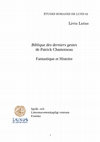
Patrick Chamoiseau is arguably the most prominent cultural personality from the French island of ... more Patrick Chamoiseau is arguably the most prominent cultural personality from the French island of Martinique. His reputation is due to the worldwide success of his novels, especially
"Texaco", winner of the Prix Goncourt-award in 1992, but also to the fact that he is the leading theorist of the Créolité, an ideological movement whose aim is to preserve the character of Creole identity and culture against the threat of assimilation. Chamoiseau’s importance in an ideological context tends to overshadow his literary qualities, his novels being often seen as
illustrations of his political ideas.
Although Chamoiseau’s ideological views aren’t totally absent from his literary work, his novels strike the reader as extremely complex constructions, containing far more than a subversive aspect. An aspect that has been neglected by the critics is for example the supernatural. Probably because of the geographic vicinity to South America, Chamoiseau’s use of the supernatural has been, rather hastily, considered as typical of magical realism or marvellous realism. This dissertation aims at showing that the fantastic, as defined by Tzvetan Todorov (1970), is better suited to describe this aspect of Chamoiseau’s novels, especially Biblique des derniers gestes (2002).
My main objective is, however, not to decide whether the novel belongs to the fantastic as a genre, but to examine the reasons why it is used. A close analysis shows that it is often in
relation to the past of Martinique that the supernatural appears. Thanks to the theory of the fantastic, I find three possible explanations of this fact. Firstly, the supernatural is
juxtaposed to the real in order to reveal its limits and its “constructedness”. Martinican past thus appears as a French construction. Secondly, the fantastic can be used to reveal the
absence of genuine Martinican history. Finally, the fantastic can be a reminder of a terrible event from the past. In conclusion it can be said that Chamoiseau uses the fantastic in order to
write the history of an event that he sees as the origin of Martinique: slavery. By doing this he contributes to the fantastic as well, by showing that it is not necessarily gratuitous and by
providing a good example of original and innovative use.
Papers by Liviu Lutas









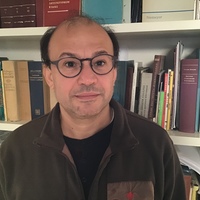
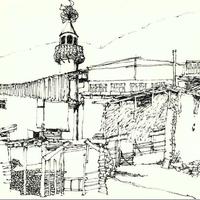
Uploads
Papers in English by Liviu Lutas
...
The aim of this study is to challenge the view that narrative metalepsis is incompatible with the writing about the past and history. I study three works by francophone writers in which metalepsis and another similar narrative device, syllepsis, are used in interesting ways in stories dealing in different ways with the past. In C F Ramuz’s short story Scène dans la forêt, both devices are used in order to give the reader the impression of being in physical contact with past events and with the fictional events represented in the story. The past here is of an individual type. In Marie NDiaye’s first story of her novel Three Strong Women, the individual past can be read as an allegory of France’s postcolonial relation to the former African colonies. Metalepsis is used in order to suggest that the character accepts her past. In Patrick Chamoiseau’s novel Biblique des derniers gestes, metalepses are used in order to suggest a physical contact with the forgotten history of slavery.
Papers in French by Liviu Lutas
Papers in Spanish by Liviu Lutas
Papers in Swedish by Liviu Lutas
Books (in French) by Liviu Lutas
"Texaco", winner of the Prix Goncourt-award in 1992, but also to the fact that he is the leading theorist of the Créolité, an ideological movement whose aim is to preserve the character of Creole identity and culture against the threat of assimilation. Chamoiseau’s importance in an ideological context tends to overshadow his literary qualities, his novels being often seen as
illustrations of his political ideas.
Although Chamoiseau’s ideological views aren’t totally absent from his literary work, his novels strike the reader as extremely complex constructions, containing far more than a subversive aspect. An aspect that has been neglected by the critics is for example the supernatural. Probably because of the geographic vicinity to South America, Chamoiseau’s use of the supernatural has been, rather hastily, considered as typical of magical realism or marvellous realism. This dissertation aims at showing that the fantastic, as defined by Tzvetan Todorov (1970), is better suited to describe this aspect of Chamoiseau’s novels, especially Biblique des derniers gestes (2002).
My main objective is, however, not to decide whether the novel belongs to the fantastic as a genre, but to examine the reasons why it is used. A close analysis shows that it is often in
relation to the past of Martinique that the supernatural appears. Thanks to the theory of the fantastic, I find three possible explanations of this fact. Firstly, the supernatural is
juxtaposed to the real in order to reveal its limits and its “constructedness”. Martinican past thus appears as a French construction. Secondly, the fantastic can be used to reveal the
absence of genuine Martinican history. Finally, the fantastic can be a reminder of a terrible event from the past. In conclusion it can be said that Chamoiseau uses the fantastic in order to
write the history of an event that he sees as the origin of Martinique: slavery. By doing this he contributes to the fantastic as well, by showing that it is not necessarily gratuitous and by
providing a good example of original and innovative use.
Papers by Liviu Lutas
...
The aim of this study is to challenge the view that narrative metalepsis is incompatible with the writing about the past and history. I study three works by francophone writers in which metalepsis and another similar narrative device, syllepsis, are used in interesting ways in stories dealing in different ways with the past. In C F Ramuz’s short story Scène dans la forêt, both devices are used in order to give the reader the impression of being in physical contact with past events and with the fictional events represented in the story. The past here is of an individual type. In Marie NDiaye’s first story of her novel Three Strong Women, the individual past can be read as an allegory of France’s postcolonial relation to the former African colonies. Metalepsis is used in order to suggest that the character accepts her past. In Patrick Chamoiseau’s novel Biblique des derniers gestes, metalepses are used in order to suggest a physical contact with the forgotten history of slavery.
"Texaco", winner of the Prix Goncourt-award in 1992, but also to the fact that he is the leading theorist of the Créolité, an ideological movement whose aim is to preserve the character of Creole identity and culture against the threat of assimilation. Chamoiseau’s importance in an ideological context tends to overshadow his literary qualities, his novels being often seen as
illustrations of his political ideas.
Although Chamoiseau’s ideological views aren’t totally absent from his literary work, his novels strike the reader as extremely complex constructions, containing far more than a subversive aspect. An aspect that has been neglected by the critics is for example the supernatural. Probably because of the geographic vicinity to South America, Chamoiseau’s use of the supernatural has been, rather hastily, considered as typical of magical realism or marvellous realism. This dissertation aims at showing that the fantastic, as defined by Tzvetan Todorov (1970), is better suited to describe this aspect of Chamoiseau’s novels, especially Biblique des derniers gestes (2002).
My main objective is, however, not to decide whether the novel belongs to the fantastic as a genre, but to examine the reasons why it is used. A close analysis shows that it is often in
relation to the past of Martinique that the supernatural appears. Thanks to the theory of the fantastic, I find three possible explanations of this fact. Firstly, the supernatural is
juxtaposed to the real in order to reveal its limits and its “constructedness”. Martinican past thus appears as a French construction. Secondly, the fantastic can be used to reveal the
absence of genuine Martinican history. Finally, the fantastic can be a reminder of a terrible event from the past. In conclusion it can be said that Chamoiseau uses the fantastic in order to
write the history of an event that he sees as the origin of Martinique: slavery. By doing this he contributes to the fantastic as well, by showing that it is not necessarily gratuitous and by
providing a good example of original and innovative use.